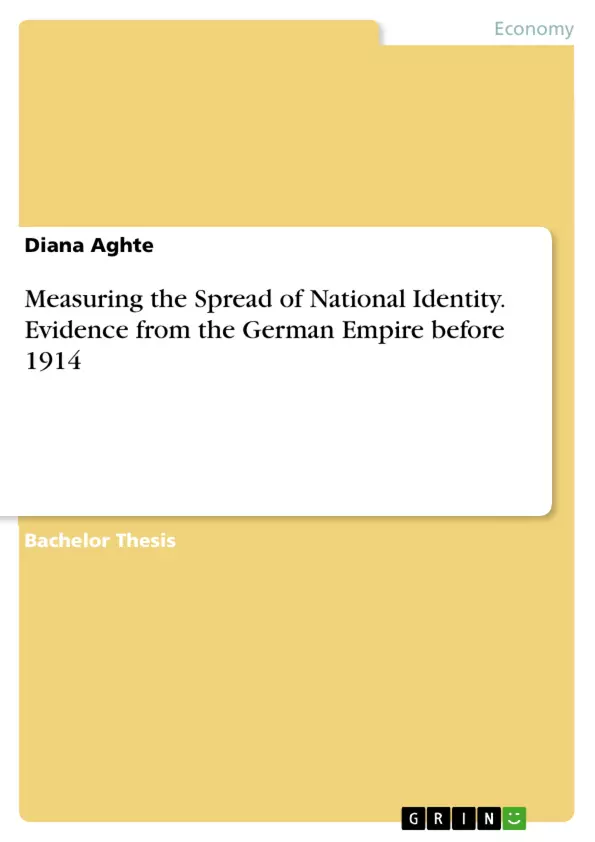National identity is a significant aspect in the unification process of a nation, especially within the context of structural change in an emerging industrial state. This work aims to identify the spread of national identity within the German Empire, as it sought to establish its economic integration into the world market. As a symbol of identification the German fleet and its relations will be the focus of observation.
Germany and its position within Europe is a special case. The manifold fragmentations along political, religious and cultural lines is a particularly interesting aspect of the emergence of the national state, although its complexity makes it difficult to describe and there are still many gaps in the research. To understand the character of Germany's national identity before 1914 it is crucial to analyze the historical, political, economic and social circumstances to build a meaningful framework. The German Empire's newness as a state and its immense pace of industrial development gave rise to very unique structural dynamics.
Inhaltsverzeichnis (Table of Contents)
- Introduction and Literature Review
- Data evaluation and empirical methods
- 1. Socio-Theoretical Frameworks
- 1.1 Nation building and class struggles
- 1.2 State, Nation and Nationalism
- 1.3 The Concept of Fashion within the Theoretical Framework of Social Systems
- 2. Historical Reconstruction
- 2.1. Political Structure of Germany before 1871
- 2.2 The German Empire
- 2.3 The German Industrialization
- 2.4 Tirpitz Propaganda
- 2.5 The Anglo-German Naval Race
- 3. QHI: How the Elites' Influence on the Expansion of Naval Power built National Identity within the German Society
- 4. QH2: The Symbolism of the Sailor Suit and Mass Production as Unifying Forces on the Example of the Manufacturer Bleyle
- 5. QH3: Negative Stereotypes and the Image of the Enemy as Creators of National Identity
Zielsetzung und Themenschwerpunkte (Objectives and Key Themes)
This work delves into the development of national identity within the German Empire during its industrialization and integration into the global market, focusing on the German fleet as a symbol of national identification. It aims to understand how the nation-building process was shaped by the influence of elites, the symbolism of fashion, and the role of negative stereotypes.
- The impact of the German fleet on national identity formation.
- The interplay between economic development and national identity.
- The role of elite influence and propaganda in shaping national consciousness.
- The symbolism of fashion, particularly the sailor suit, as a unifying force.
- The function of negative stereotypes and the image of the enemy in constructing national identity.
Zusammenfassung der Kapitel (Chapter Summaries)
The initial chapters establish a socio-theoretical framework, outlining nation-building processes in the context of class struggles and analyzing the role of the state, nation, and nationalism in shaping national identity. They further examine the concept of fashion within the theoretical framework of social systems.
The following chapters provide a historical reconstruction of Germany leading up to 1871, highlighting the political and economic factors contributing to the rise of the German Empire. They explore the German Industrialization, Tirpitz propaganda, and the Anglo-German Naval Race, offering insights into the rivalry between the two empires.
Subsequent chapters delve into specific quasi-hypotheses, examining how the elites' influence on the expansion of naval power shaped national identity within German society. They analyze the symbolism of the sailor suit and mass production as unifying forces, exemplified by the manufacturer Bleyle, and explore the role of negative stereotypes and the image of the enemy in creating national identity.
Schlüsselwörter (Keywords)
This research focuses on national identity, nation-building, the German Empire, industrialization, the German fleet, symbolism, fashion, the sailor suit, propaganda, negative stereotypes, and the image of the enemy. It draws upon theories of social systems, class struggles, state-led modernization, and historical analysis to understand the complex relationship between economic development, political dynamics, and national consciousness.
- Citation du texte
- Diana Aghte (Auteur), 2021, Measuring the Spread of National Identity. Evidence from the German Empire before 1914, Munich, GRIN Verlag, https://www.grin.com/document/1316592



